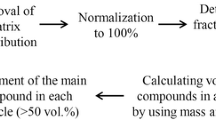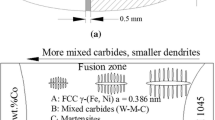Abstract
A numerical procedure based on finite difference method was used to simulate the formation of ‘hard’ and ‘soft’ zones, in dissimilar weldments of 9Cr–1Mo and 2¼Cr–1Mo steels during high temperature exposure. Kinetic analysis of the calculated diffusion profiles showed that the activation energy for carbon diffusion in Cr–Mo steels is marginally higher than that in Fe–C system. Calculations were extended to incorporate the effect of Ni-based interlayers between 2¼Cr–1Mo and 9Cr–1Mo ferritic steels. The presence of a diffusion barrier was found to reduce the propensity for formation of hard and soft zones, which is related to the interaction parameter \( \varepsilon_{\rm C}^{\rm M}. \) Thickness of the interlayer required to suppress the formation of hard zone was optimized by the calculations. Transition joints of ferritic steels with Inconel 182 as the interlayer of thickness close to that predicted by the computations were fabricated and exposed to elevated temperature. Microstructural studies and hardness measurements further confirmed the effectiveness of Ni-based interlayers in preventing hard zone formation.








Similar content being viewed by others
References
Kim BC, Ann HS, Song JT (1992) In: Proceedings of the international trends in welding science and technology. ASM International, Materials Park, Ohio, pp 307–312
Albert SK, Gill TPS, Tyagi AK, Mannan SL, Kulkarni SD, Rodriguez P (1997) Weld J 76:135
Lundin CD, Khan KK, Yang D (1996) Report No. 1 WRC Bull 407:1
Lundin CD, Khan KK, Yang D (1990) In: Proceedings of the recent trends in welding science and technology. ASM International, Materials Park, Ohio, pp 291–297
Goldstein JI, Moren AE (1978) Metall Trans 9A:1515
Farkas D, Ohla K (1983) Oxid Met 19:99
Bongartz K, Lupton DF, Schuster H (1980) Metall Trans 11A:1883
Morral JE, Dupen BM, Law CC (1992) Metall Trans 23A:2069
Buchmayr B (1990) Fundamentals and applications of ternary diffusion. Pergamon Press, New York, pp 227–240
Kirkaldy JS (1971) Oxidation of metals and alloys. ASM, Ohio, pp 101–114
Engström A, Höglund L, Ågren J (1994) Metall Trans 25A:1127
Kozeschnik E, Pölt P, Brett S, Buchmayr B (2002) Sci Technol Weld Join 7:63
Kozeschnik E, Warbichler P, Letofsky-Papst I, Brett S, Buchmayr B (2002) Sci Technol Weld Join 7:69
Kucera J, Vrestal J, Stránskỳ K (1989) Defect Diffus Forum 66–69:1395
Gauzzi F, Missori S (1988) J Mater Sci 23:782. doi:https://doi.org/10.1007/BF01153967
Sudha C, Terrance ALE, Albert SK, Vijayalakshmi M (2002) J Nucl Mater 302:193
Sudha C, Terrance ALE, Vijayalakshmi M (2002) In: Proceedings of the IIW Asian pacific international congress, Singapore. Welding Institute of Australia, pp 1–15
Sudha C, Thomas Paul V, Terrance ALE, Saroja S, Vijayalakshmi M (2006) Weld J 85:71
Huang ML, Wang L (1998) Metall Trans 29A:3037
Pavlovsky J, Million B, Ciha K, Stránskỳ K (1991) Mater Sci Eng A 149:105
Londolt B (1990) Diffusion in solids, metals and alloys. Springer-Verlag, Berlin, pp 372–435
Wada H (1985) Metall Trans 16A:1479
Lupis CHP (1983) Chemical thermodynamics. Oxford University Press, North Holland, pp 491–501
Crank J (1956) The mathematics of diffusion. Oxford University Press, Oxford, pp 150–186
Birchenall CE, Mehl RF (1947) Trans AIME 171:143
Kucera J, Stránskỳ K (1982) Mater Sci Eng 52:1
Acknowledgements
The authors thank Dr. Baldev Raj, Director, IGCAR, and Dr. P. R. Vasudeva Rao, Director, Metallurgy and Materials Group, for their support and encouragement for this project. The authors also thank Dr. S. K. Albert and Dr. K. Laha, Scientific Officers, MMG, IGCAR, for their help and useful suggestions.
Author information
Authors and Affiliations
Corresponding author
Appendix
Appendix
Simulation of carbon diffusion profiles.
The sole objective of the model is to demonstrate the effectiveness of Ni-based interlayer in preventing the hard zone formation. For this purpose a simple single-phase model is considered, which does not take into account the precipitation of carbides.
The change in concentration of a diffusing element with respect to time can be obtained from the well-known Fick’s second law of diffusion,
where ‘D’ is the diffusion coefficient of the element in solid solution, ‘C’ is the concentration of the element in solution, ‘t’ is the time, and ‘x’ is the distance. The system under consideration is a ternary system of Fe–M–C type where ‘M’ indicates any major substitutional alloying element like Cr, Ni, or Mo. In the present case, the major alloying element considered is Cr. For ternary diffusion, Fick’s second law can be rewritten using Onsager’s equation [5] as
where C1 and C2 refer to carbon and chromium concentration in solution. D11 and D22 are the self-diffusion coefficients of carbon and chromium in solution, respectively. D12 and D21 are the cross diffusion coefficients, which take into consideration the effect of one element on the other. Expanding the R.H.S. of Eqs. 3 and 4 we get
Since the contribution due to \( \frac{{\partial D_{11} }}{\partial x},\) \( \frac{{\partial D_{12} }}{\partial x},\) \( \frac{{\partial D_{22} }}{\partial x},\) and \( \frac{{\partial D_{21} }}{\partial x} \) is zero, they are neglected. Then the above equations can be simplified as
Using Schmit method [24] the differential Eqs. 7 and 8 can be transformed to finite differential equations using a one-dimensional grid of mesh points in space x and time t. The mesh points are separated by a space increment of Δx and time increment Δt. For carbon, the second differential of concentration with respect to space can be written as
and the first differential of concentration with respect to time is
Similarly for chromium,
Substituting Eqs. 9, 10, and 11 in Eq. 7 and Eqs. 9, 11, and 12 in Eq. 8, the change in concentration with respect to time for a particular grid point is obtained as
where
To calculate the change in the values of C1 and C2 for each mesh element as a function of Δt from Eqs. 13 and 14, the values of D11, D12, D21, and D22 should be known. These values can be calculated as follows.
According to Birchenall and Mehl [25] flux of any diffusing element can be expressed in terms of its activity as
where Da is the activity diffusion coefficient of carbon. If it is assumed that component 1 (carbon) is a relatively dilute interstitial and component 2 (chromium in this case) is a dilute substitutional component of a ternary alloy, then
where X1 is the mole fraction of component 1. In terms of activity coefficient γ1, the Wagner interaction parameter is given as
In such a case Da can be assumed to be constant. This assumption has been used earlier by Buchmayr [9] and Kucera et al. [26] for simulating the carbon concentration profiles in dissimilar weldments. For ternary alloys, activity of carbon aC is given by Eq. 1 [16] where the values of interaction parameter are taken as \( \varepsilon_{\text{C}}^{\text{C}} \) = +1.33 and \( \varepsilon_{\text{C}}^{\text{Cr}} \) = −72 [22] for Fe–Cr–C system and \( \varepsilon_{\text{C}}^{\text{Ni}} \) = +2 [23] for Ni–Cr–C system. Upon substituting Eq. 1 in Eq. 15, the flux can be rewritten as
Comparing the above equation with Fick’s first law
the values of diffusion coefficients for carbon can be obtained as
and
Similar analogy can be used to calculate diffusion coefficients for chromium as
and
\( \varepsilon_{\text{Cr}}^{\text{Cr}} \) is the Cr–Cr interaction parameter, which is taken as −5 [22]. DC and DCr are concentration independent diffusion coefficients, D(0), for carbon and chromium, respectively. In the calculation, values of DC and DCr are taken as 1.05 × 10−11 m2/s and 2.51 × 10−17 m2/s, respectively, in ferritic steel and as 1.465 × 10−14 m2/s and 1.48 × 10−19 m2/s, respectively, in Ni-based interlayer [21].
The above-calculated values for diffusion coefficients are substituted in Eqs. 14a–14d. Knowing the values of C1 and C2 for the mesh points x, x + 1, and x − 1 for a particular time ‘t,’ C (x, t + Δt) can be calculated. The calculations were carried out on a one-dimensional finite difference mesh with 100 mesh points. To minimize the error, the width of each mesh point Δx is kept as 0.003 mm. Time increment is calculated from the criteria
Detailed flow chart of the computer program that was developed to solve the numerical equations is given in Fig. 1.
Rights and permissions
About this article
Cite this article
Anand, R., Sudha, C., Karthikeyan, T. et al. Effectiveness of Ni-based diffusion barriers in preventing hard zone formation in ferritic steel joints. J Mater Sci 44, 257–265 (2009). https://doi.org/10.1007/s10853-008-3052-9
Received:
Accepted:
Published:
Issue Date:
DOI: https://doi.org/10.1007/s10853-008-3052-9




